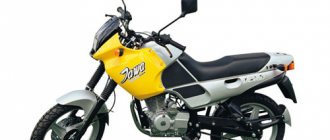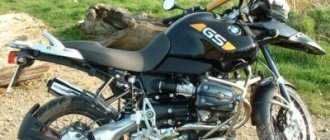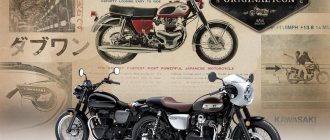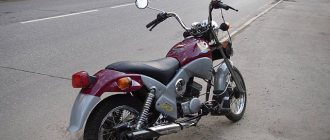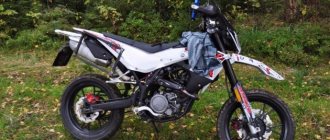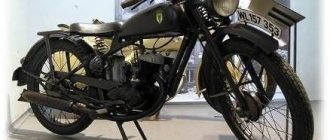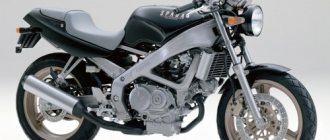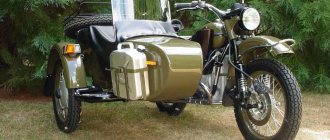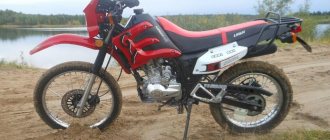| Engine and transmission | |
| Volume | 651.90 ccm (39.78 cubic inches) |
| engine's type | Single cylinder, four-stroke |
| Power | 46.26 HP (33.8 kW)) @ 6500 RPM |
| Torque | 57.00 Nm (5.8 kgf-m or 42.0 ft.lbs) @ 5000 RPM |
| Maximum speed | 155.0 km/h (96.3 mph) |
| Compression | 9.7 |
| Diameter, stroke | 100.0 x 83.0 mm (3.9 x 3.3 inches) |
| Transmission | 5-speed |
| Chassis, suspension, brakes, wheels | |
| Tires, front | 90/90-18 |
| Tires, rear | 130/90-16 |
| Brakes, front | Single disc |
| Brake disc diameter, front | 320 mm (12.6 inches) |
| Brakes, rear | Single disc |
| Brake disc diameter, rear | 220 mm (8.7 inches) |
| Dimensions | |
| Weight, dry | 180.0 kg (396.8 pounds) |
| Power/weight ratio | 0.2570 HP/kg |
| Seat height | 750 mm (29.5 inches) If adjustable, lowest setting. |
| Wheelbase | 1,525 mm (60.0 inches) |
| Gas tank volume | 14.20 liters (3.75 gallons) |
| Fuel tank volume, reserve | 1.50 liters (0.40 gallons) |
| Other characteristics | |
| Strater | Electric |
Call center 24 hours. Any questions from those. consultations to assistance with placing an order.
Warranty on all products
Warranty for goods from 6 months to 3 years. If there is a defect, we will replace the product without any questions asked.
Secure payment methods
Pay by credit card, PayPal, bank transfer or cash upon delivery.
Delivery throughout Russia
You can choose delivery by courier, Russian Post or at a pick-up point.
We will pack it well, send it for delivery and monitor the order until delivery.
Motorcycle appearance
At first glance, the 650 attracts a lot of attention. The motorcycle looks impressive, somewhat heavy, but there is no feeling that it is clumsy. What’s remarkable is that if you get to know this bike better, the reason for this impression becomes clear. The Java 650 is equipped with the most powerful engine among the entire line of motorcycles from the Czech manufacturer.
As befits a flagship, the Java 650 looks solid and expensive. The status of the motorcycle is emphasized by numerous chrome parts and a balanced appearance as a whole. Despite the modern American design style, looking at the bike you can catch touches that are unique to the Czechs.
The teardrop-shaped motorcycle tank looks very harmonious. It is massive to match the bike , but neat . The exhaust pipe deserves special attention. It has a twin shape and looks in an overtly retro style. If we talk about the latter, then the motorcycle is simply permeated with it. The headlight is very similar to those that were equipped with Soviet motorcycles in the 70s.
The dashboard also looks quite old-fashioned. The indicators are made in the form of light bulbs, and the speedometer is laconic and simple. If you look at the photo of the Java 650 not in full size, but in detail, you get the feeling that before your eyes is an American motorcycle from the mid-20th century. The windshield for the bike is purchased separately, at the discretion of the buyer.
Technical characteristics of Java 650 Classic
| Engine's type: | single cylinder, four stroke |
| Cooling type: | water |
| Number of cylinders: | 1 |
| Piston diameter and stroke, mm: | 100 to 83 |
| Engine capacity, cmcm: | 651,9 |
| Compression ratio: | 9,7 |
| Max. power: | 35,4 |
| Ignition system: | electric starter |
| Number of gears: | 5 |
| Wheelbase, mm: | 1525 |
| Saddle height, mm: | 712 |
| Tank volume, l: | 14 |
| Wheels (Front; Rear): | 2.15 by 18; 2.5 by 16 |
| Tires (front; rear): | 90/90-18″; 130/90-16″ |
| Front suspension: | telescopic type |
| Rear suspension: | pendulum type |
| Brakes (front, rear), mm: | hydraulic, disc, 320; 220 |
| Weight, kg.: | 180 |
| Maximum speed, km/h: | 155 |
The 650 is powered by Bombardier's proven, water-cooled Rotax engine with a four-valve cylinder head. In addition to the Czech motorcycle, similar power units were installed on the Aprillia Pegaso Strada/Trail and BMW F650.
The manufacturer recommends using fuel of at least grade 92. At the same time, acceleration to one hundred kilometers is achieved in 6.4 seconds. The Java 650 classic comes from the factory with high-quality locally produced tires from.
Power unit
The Java 650 motorcycle in the Classic version is equipped with a purchased Rotax engine (model 654 DS) with a power of 48 hp. (35.4 kW) at 6500 rpm. At that time, it was a very modern power unit, which was installed on motorcycles from many manufacturers. The starting system is from an electric starter. The power unit is a four-stroke single-cylinder engine with a displacement of 652 cm3. Thanks to this high indicator, the torque is 57 N/m and is achieved at 5 thousand revolutions.
The cylinder head has 4 valves, and the camshafts in the head are driven by a chain. The engine has a liquid cooling system and a dry sump lubrication system. Despite the fairly high compression ratio, the motorcycle can run on A92 gasoline. Although it is more desirable to use A95.
Due to the relative simplicity of the design and low boost, the engine is not picky in maintenance and has a long service life (especially in comparison with old 2-stroke engines). The transmission has 5 speeds and is supplied by Rotax with the engine.
Is it worth buying
As mentioned above, the choice of a particular motorcycle cannot be justified solely by pragmatic criteria. Fuel consumption, maximum speed and even cost are secondary issues. Much more important is the legend, the history of the motorcycle. Some people are interested in it, but others are indifferent to it. In the case of the 650 Java, this is exactly the case.
The price of the bike is quite high , at the level of a several-year-old Japanese bike, but this will not stop a person who wants to purchase this particular motorcycle. With similar confidence, we can say that anyone who frankly does not like Czech will not buy it even for half the price. If we try to be objective, then the disadvantages of the Java 650 Classic can still be identified:
- relatively high cost;
- difficulties with original spare parts;
- design “for everyone”;
That's all; we found no other serious shortcomings in the Czech motorcycle. Maybe you have something to add? Write in the comments!
Best Used 650-900cc Dual-Sport Adventure Motorcycles
Among the bikes in this short review there is a model for every taste and color, from simple and uncomplicated dual-sports with air-air motors to powerful two-wheeled mustangs with advanced water-air engines. And the most important thing is that when you sell them you will hardly lose in price, which makes these bikes even more attractive. This group will include dual-purpose motorcycles (asphalt-off-road) with an engine capacity from 650 to 900 cc. cm.
Looking ahead, it should be noted that some of the motorcycles presented here are real dinosaurs from that glorious, but long-gone era of roaring single-cylinder engines. A time when deafening engines emitting pillars of smoke were akin to fire-breathing dragons and aroused the awe of passers-by. In addition to the old ones, newer models will be listed here. Refined and improved. With injectors, ABS system, spacious fuel tanks and powerful engines. The selection ranges from bikes that are equipped to the teeth and built to last for hours on the road, to lean enduros built to take on the wildest off-road terrain. In general, everyone will find something for themselves here.
BMW F800 GS/ GS Adventure
At the time of its release, this bike boasted a very powerful engine, comparable to the previous generation R1150GS model. The new 798cc fuel-injected parallel twin was a welcome alternative to the bulkier 1000cc-plus touring enduros that dominated the market at the time. The F800GS quickly gained the attention of touring enthusiasts. It has a powerful engine, a fuel-injected two-cylinder engine, and most importantly, it weighs less than its older brothers in this segment.
Instead of a driveshaft like the R-GS models, the F800GS has a chain drive. It is easier to maintain, but requires constant care. If you spend a little extra money, you can find the F800GS Adventure loaded with useful gadgets. They rolled off the assembly line several years after the release of the first model. The expenses are justified. The kit includes electronic suspension control and stability control. It's worth noting, however, that if something goes wrong with the electronics and you're in the middle of the desert thousands of miles from service... well, you get the idea. Another negative is that the suspension has limited adjustability, which can affect the ride quality over rough terrain. The new Adventure model features a refined appearance, a generous 24-liter fuel tank (compared to 16-liter capacity in standard models), a wide windshield, luggage mounts for panniers and protective covers for the engine. All this beauty added almost 14 kg of extra weight to the bike. So don't be in a hurry to part with your money. If all you need is an engine guard and a slider, then it will be cheaper to invest in tuning a standard model.
The F800GS has a very powerful generator that produces 400 watts of power. The ground clearance is quite decent for such a large bike, which makes it possible to lower the saddle to 84 cm. This model can be classified as the heavy artillery in its subgroup. However, the 90/90-21 front wheel, identical to the Tiger 800 XC, will allow you to ride on any type of road in comfort. Overall, this is a great dual sport that can cover long distances with ease without letting you get bored.
PROS:
▲ Powerful generator;
▲ Decent ground clearance for a large bike;
▲ Great possibilities for tuning;
MINUSES
▼ Limited suspension adjustment;
▼ Recalls of the first models from the market due to technical faults;
Triumph Tiger 800 XC
A direct competitor to the motorcycle discussed above is the Tiger 800XC - another prominent representative of touring enduros with a multi-cylinder engine and relatively light weight. The smooth 799cc three-cylinder engine is slightly more powerful than the BMW's, but doesn't offer the same low-end torque. This bike also has adjustable suspension, but the ground clearance is not as good as the boomer. However, these differences will only be noticeable when driving quite aggressively on difficult terrain, where the Tiger loses a little to its German brother. The 800XC's steering is quite stiff, and when riding at low speeds over obstacles, the bike feels unwieldy. The weight emphasis on the front wheel adds to the discomfort. But, on the other hand, the suspension is relatively softer.
The generator produces an incredible 645 watts. It's basically a microwave on wheels. As for electronics, the Tiger 800XC is equipped with an injector, a switchable ABS system, and, since 2015, also a traction control system. However, like other modern models, troubleshooting when it comes to electronics is a very difficult task. For example, if water flooded the dashboard while crossing a river and the bike stalled, then it’s time to call the emergency lights.
The height of the saddle can be adjusted if desired. The 19-liter fuel tank is quite spacious, which is a definite plus if you are used to covering long distances. The reliable and powerful motor behaves simply perfectly at high speeds. The variety and availability of luggage accessories, protective covers, cages and sliders place this bike at the top of the modern adventure enduro category. In the right hands, Tiger is capable of a lot on and off the pavement.
PROS
▲ Powerful engine;
▲ Adjustable saddle height;
▲ Impressive 645 Watt generator;
MINUSES
▼ The ergonomics of the bike are not ideal for low speeds on difficult terrain;
▼ Electronics occasionally play pranks;
Suzuki DL650 V- Strom
From a technical point of view, this motorcycle does not belong to the dual-sport class due to the geometry of the chassis and alloy wheels. However, in reality, the DL650 V-Strom is surprisingly good on both tarmac and sand dunes. This is perhaps the most comfortable bike of all the mentioned 650 cc motorcycles. Largely thanks to the V-twin engine, which purrs like a well-fed cat and does not shake the bike like an earthquake. Other advantages include a wide windshield, 19-inch front wheel, fuel-injected engine and adjustable saddle height (lowers to 81 cm). Of course, there is also ABS, but to disable the system you will have to seriously tinker.
These bikes have great potential. Weighing in at under 223kg, the DL650 is poised to become your favorite. A relatively large 22-liter fuel tank eliminates the inconvenience of constant stops for refueling, and the upright seating position ensures comfort during long rides. Since the release of the first model in 2004. the motorcycle has undergone minor changes. In 2007 dual spark plugs and ABS were added, followed a year later by a more powerful alternator. Four years later, the model was modified in all seriousness. The appearance was improved, travel was added to the rear suspension, and the fork was changed to a stiffer one. We also didn’t forget about the engine power. But the capacity of the fuel tank was reduced by 2 liters. A kind of compromise to achieve less weight. All these changes undoubtedly make this motorcycle a worthy purchase.
The Suzuki 650 V-Strom has been on the market for more than a decade, and its popularity has not waned. The generator power allows you to connect modern electronic accessories, and the comfortable seating will give you comfort if you spend long hours in the saddle.
PROS
▲ Low saddle height;
▲ Very smooth injection engine with good, smooth power already after 650 rpm;
▲ High generator power;
MINUSES
▼ Relatively low ground clearance and limited suspension adjustment;
▼ Heavy weight for a motorcycle in its category;
BMW F650 GS/ GS Dakar
Of the 650 cc single-cylinder engines, this Bavarian is, without a doubt, the most powerful (we are talking about those early single-cylinder models up to 2007 inclusive, because from 2008 to 2010 a two-cylinder model with a volume of 800 cc was produced under the same index) . On asphalt it has no equal. But even outside the asphalt surface, it feels like a fish in water, especially in the hands of an experienced pilot. This bike is literally crammed with useful gadgets. Its tamed engine power and one of the lowest seats in its class make it particularly attractive to first-timers. Add to it a low center of gravity, fairing, ABS, and you get an ideal model for beginner motorcyclists. And this handsome man weighs only 190 kg. Since 2000 to 2007 The F650GS and F650GS Dakar models that rolled off production lines were equipped with a liquid-cooled, fuel-injected Rotax engine. The engine itself was reliable, but there were some minor problems with the injector. In early 2004, this problem was solved by adding a new fuel supply system and a second spark plug, which reduced fuel consumption to 4 liters per 100 kilometers.
Dakars have an SUV-appropriate 21-inch front wheel, but also a correspondingly higher seat and long suspension travel. Both GS models feature a simple fork with shock-absorbing bars and relatively short suspension travel: 17 cm for the standard model and 21 cm for the Dakar model. The pride of the 650GS is its 400-watt generator. With such a superman, you can use foglights, heated seats and steering wheel, charge GPS and phone without a second thought. And all this at the same time. No other bike in this size, except perhaps the V-Strom, can boast such a strong generator.
The ABS system can be turned off, which is an important condition if you are driving off the asphalt and especially when going down a hill. And the standard model's 19-inch spoked front wheel is as good as, if not better than, the alloy wheels found on competing models. With a huge selection of luggage accessories, the F650GS is a favorite among long-distance travelers around the world.
PROS
▲ Relatively low saddle;
▲ Powerful generator;
▲ Proven reliability and impressive engine power for its class;
MINUSES
▼ Limited ground clearance and suspension travel in conventional versions;
▼ Problems with the injector in early models produced before 2004;
Kawasaki KLR650
Speaking of the KLR650, it is, first of all, an ideal dual sport that fits perfectly between the F650GS and DR650SE. It is more designed for asphalt surfaces, but also performs very well off-road. The liquid-cooled two-cylinder engine is more demanding to maintain than its single-cylinder competitors, but the difference is not obvious. The downside is that with a soft basic suspension and a ground clearance of less than 23 cm, you won’t be able to accelerate very much off-road. In addition, the high center of gravity makes maneuvering at low speeds on difficult terrain difficult. But the KLR650 has one of the largest fuel tanks in its class, and the wide, comfortable seat and fairing provide the comfort needed for long trips.
The history of the bike’s creation began back in 1987 with the KLR600 model, which nine years later was reborn into the KLR650. In 2008, it was sent for modernization, as a result of which the motorcycle received a much more attractive appearance, new brakes, stiffer suspension with less travel and a number of other improvements. The well-known Achilles heel of the KLR650 is the timing chain tensioner adjuster lever (doohickey). It is quite flimsy in all models, regardless of the year of manufacture. To avoid unnecessary headaches, many motorcyclists recommend replacing it immediately after purchasing the motorcycle. In 2014, the bike was updated again, slightly changing the shape of the saddle and making the suspension more rigid. However, the height of the motorcycle along the saddle remained the same (89cm).
It’s surprising that in just over thirty years the bike’s equipment has hardly changed. The KLR650 has become something of a classic. The engine and frame have not undergone significant changes, so there is no shortage of spare parts. The selection of luggage accessories is large. The Internet is replete with videos and articles on self-care. And with a little customization, this motorcycle will serve you—without exaggeration—forever. Many have already proven this. If you are a KLR owner, then you will understand what we are talking about.
PROS
▲ A huge number of available online resources for self-maintenance of the bike;
▲ Reliability proven over decades;
▲ Large 23-liter fuel tank and a wide selection of luggage accessories;
MINUSES
▼ Limited suspension and low ground clearance;
▼ The balance shaft chain tensioner (doohickey), in a good way, requires immediate replacement with a reinforced one (with a spring designed for torsion). The good news is that this only needs to be done once, it takes even an inexperienced mechanic about 40 minutes, and after replacement this problem disappears forever.
Suzuki DR650 SE
If you're looking for a low-budget, reliable dual sport, you've found it. This motorcycle will quench your thirst for riding both on city roads and on mountain trails with the same effect. After minor tweaks over the years, the Suzuki team has perfected the DR650SE.
Between 1991 and 2005, this bike underwent a number of changes. The design of the frame and suspension was improved, and the engine was replaced. But after this, no significant upgrades occurred for almost sixteen years. By the way, if you are purchasing a 1998 or 1999 model, pay attention to the starter idler gear. This is a sore spot for them. And in general, regardless of the year of manufacture, it is better to make sure that the neutral sensor unit has a thread lock so that the nuts do not fall into the engine. Just like with the KLR, once this “jamb” is eliminated, the DR650SE will last you forever.
The motorcycle has a good ground clearance of 26 cm and a high windshield for better protection from the wind. The standard model is available with an oil cooler. Relatively low weight (only 166 kg) and a low 89 cm seat make the bike attractive for beginners. This motorcycle is better suited than others in its group for riding on open spaces that are not rolled into asphalt, and can become an excellent companion for both beginners in the motorcycle world and for experienced riders.
PROS
▲ Air-oil-cooled engine is simple and reliable;
▲ Low seat with good ground clearance;
▲ Numerous online resources will help with self-care;
MINUSES
▼ Soft suspension;
▼ The thread lock for the neutral sensor needs to be replaced;
Honda XR650L _
In its 24 years of existence, the XR650L hasn't changed a bit. No other dual-sport motorcycle has as many accolades in cross-country racing as the XR650L. It made a name for itself in the Baja 1000 across the Mexican desert, made waves in American enduro racing competitions, and made its mark in the international six-day enduro challenge. Thanks to the adjustable cartridge forks and adaptive rear shock absorber, it has reliable suspension even for its age. A generous 33cm of ground clearance, an 18-inch rear wheel with enduro tyres, no rubber shock absorber on the rear wheel hub, no tachometer, poor wind protection and a weight of almost 45kg less than the KLR and F650GS make this bike more suitable for bumpy roads. landscapes rather than riding on city streets.
This motorcycle is a prime example of a hard-to-achieve compromise in dual sports, where the enduro side has gained the upper hand. Highway riding on this bike will be less than comfortable. The rear tires will wear out quickly, and the height puts the bike in the realm of full-fledged motocrossers. However, the captivating light weight of just over 156 kg puts the XR650L at the forefront of the 650 cc Japanese. It also boasts the best ground clearance in its class.
The single-cylinder blower engine is reliable and easy to maintain, and the market is full of options for budget customization. So, if desired, this bike can very well become a reliable companion if you prefer to ride mainly off the asphalt.
BEHIND
▲ Excellent adjustable Showa suspension, despite its age;
▲ Best ground clearance in its class;
▲ Lightweight;
AGAINST
▼ Small fuel tank with a capacity of only 7.6 liters (plus a reserve of 2.3 liters);
▼ There is no oil cooling system, but if you don’t ride this enduro on asphalt for a long distance, then the oil system, as a rule, can withstand without additional cooling. Some craftsmen, if necessary, install oil cooling radiators from other models.
KTM 640 Adventure/ KTM 690 Enduro R
The KTM team managed to equip the lightweight KTM640 Adventure with a spacious 25-liter fuel tank, fairing and liquid-cooled engine. At the same time, the bike weighs just over 181 kg. There was no compromise here. The motorcycle is light, but at the same time quite high (94 cm at the saddle), with a ground clearance of more than 30 cm. This makes it cumbersome at low speeds, especially on uneven terrain. In this regard, its brother 640 Enduro looks much better. However, the adventure has an adjustable suspension with long travel. The bike has both an electric starter and a kickstarter. This is a huge plus for those who like to travel to remote corners of the planet.
Despite the resounding success of the LC4 engine platform in the Dakar Rally, early 640 models were not particularly reliable. By 2004, the shortcomings had been largely eliminated, but it would be hard to call the ride smooth on this bike. The powerful 625cc liquid-cooled engine causes the bike to vibrate noticeably at high speeds, and the seat is anything but soft. But here it’s up to you to decide whether shaking when driving can scare you away from buying this more than worthy dual.
In 2004 The brakes were modified and improved, and dual front discs were added. Other parts, such as the suspension and carburetor, have also been upgraded. The appearance of the bike has also become more presentable over time. With modern suspension, impressive power, fairing and one of the largest fuel tanks in its class, this bike is ready for any day of adventure. Add panniers or bags, and the KTM 640 will take you to even the most remote point on the planet in comfort and with a breeze.
The KTM 640 is equipped with the LC4 engine, which has rightfully won the reputation of the most powerful single-cylinder engine. Its brother, the KTM 690 Enduro R, was first introduced to the public in 2009, where it was instantly recognized as the best dual sport. Add to this Brembo brakes with ABS, an impressive WP shock absorber, and you have a motorcycle that can satisfy even the most demanding riders. Due to its popularity, the KTM 690 Enduro R is selling like hotcakes.
PROS
▲ Adjustable suspension and excellent road visibility;
▲ Impressive motor power and reliable engine;
▲ Excellent ergonomics, especially for driving on difficult terrain, and a spacious fuel tank;
MINUSES
▼ Uncomfortable when driving at high speed;
▼ Models released before 2004 are not very reliable;
Depending on your riding style, you might also want to consider the Honda XRV750 Africa Twin, a descendant of the famous Dakar Rally winner NXR750.
Another liquid-cooled Honda that hit the market in the late 1980s, the XL600V Transalp has long been a legend. Also worth mentioning is the Yamaha XT660Z, which is based on the XT600 with a supercharged engine. This model is rightfully considered a worthy bike in the 650 cc engine class. She was born in the late 1980s - early 1990s. If you prefer more modern lightweight Europeans, then the Husqvarna TE610 and TE630 will suit your taste. These single-cylinder Huskies have a liquid-cooled, fuel-injected engine with a 576cc engine and a 12.5-litre fuel tank. Of course, this is not a complete list of available 650-900cc dual-sport and adventure motorcycles, but the models mentioned here are the most popular in the used dual-sport market. They offer an excellent balance between price and quality, are time-tested and have successfully proven their reliability to the world. Tags: BMW Dakar BMW F650GS BMW F800GS Adventure Honda XR650L Kawasaki KLR650 KTM 640 Adventure KTM 690 Enduro moto Adventure moto Dual-Sport Suzuki DL650 V-Strom Suzuki DR650 Triumph Tiger 800XC dual-sport which motorcycle to choose the best bikes the best motorcycles moto moto adventure moto news motorcycle reviews motorcycle trips used motorcycles mid-sized motorcycles
